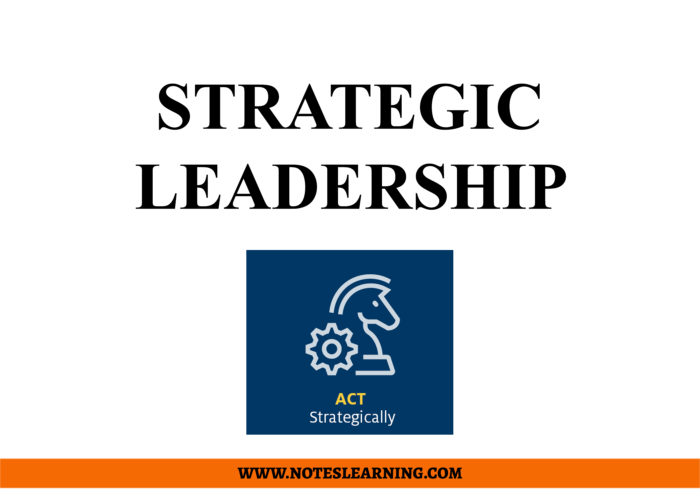WHAT IS STRATEGIC LEADERSHIP ?
Succeeding in today’s uncertain and ever-changing environment requires leadership that has vision, imagination and the ability to adapt. Strategic leadership is the process of developing a comprehensive, long-term vision for an organization with the intention to achieve that vision through the use of informed decision-making and adaptive action. It is one of the most important skills in any organization because it allows leaders to build organizational capacity, increase performance, and create sustainable competitive advantage.
Strategic leadership is a major ingredient for the successful performance of any organization operating in the ever dynamic and complex environment. This is also defined as a set of unique capabilities of anticipating, envisioning, maintaining flexibility, thinking in a strategic way, and empowering employees to generate innovative ideas that lead to high performance.
WHAT ARE THE CHARACTERISTICS OF STRATEGIC LEADERS ?
A strategic leader possesses some distinguishing characteristics. Some of such significant characteristics are:
Strategic leaders have a restlessness with the present
Strategic leaders have a creative tension which means they have a clear vision and are always thinking about their goal without distorting their current reality. Such leaders are always progressive and are able to envision the ‘ strategic leap’ that the organization needs to make. They are never satisfied with what they have and always seek for better ideas and process for better reality.
Strategic leaders prioritize their own strategic thinking and learning
The restlessness of strategic leaders lead them to continuous learning. They have a high sense of self belief without under/over stating the ground reality. Strategic leaders are highly analytical and flexible to change. As already discussed, they have the strategic leap intent while leading, which means they are continuously scanning the environment around them and preparing their strategies accordingly. Continuous learning and self belief is another characteristic of strategic leaders.
Strategic leaders create mental models to frame their understanding and practice
We know that strategic leaders are future oriented and they are continuously analyzing the environment and learning. To make this analysis and learning tangible, strategic leaders create mental models. They believe in framework and calculation. Such an approach will validate the understanding and set a guideline for the followers. Leaders lead with conviction and strategic leaders get such leading conviction after care articulation of their mental model.
Strategic leaders have powerful personal and professional network
Leaders have a strong personal and professional network. Strategic leaders believe in participative leadership and they consider the whole world a global community. Such leaders have the ability to develop personal and professional networks. They use such networks as perspectives for their model and framework and for developing and implementing strategic ideas. Strategic leaders embrace a collaborative mindset.
Similarly, there are other various characteristics of strategic leaders. Some of other characteristics are:
Strategic leaders have adaptive capacity.
- Strategic leaders have absorptive capacity.
Such leaders are able to absorb new information and assimilate such information and learn from it. Leaders are quick enough to change and reinforce existing action patterns.
- Such leaders have high endurance levels.
- Strategic leaders have strong accountability towards their responsibility.
FUNCTION AND ROLES OF STRATEGIC LEADERS
Setting direction of the organization
Strategic leaders are concerned with not just managing the present situation but setting up a framework for future, setting a direction for the organization.
Aligning the people and the organization to the strategy
A leader faces two types of changes i.e. change in mission and strategies and change in culture and behavior. Changes in mission and strategies is more of an organizational change where change in culture and behavior is more of behavioral change of human factors. Leaders are responsible for aligning people with organization i.e. motivating followers to achieve common organizational goals and changing individuals according to the strategies.
Aligning people and organization is managed by:
- Regular strategic conversation
- Motivation
- Building capability of strategic stakeholders
Determining effective intervention points – the right things at the right time
Strategic leaders are responsible for keeping things at balance. They are responsible for keeping the update of all the how, whys and whens. They have the capacity to undertake the new decision. In simplest form, they are the nucleus in an organization. They are responsible for decision making, motivation, strategy formulation, resource allocation. They manage to do the right thing at the right time.
Developing strategic capabilities
Strategic leaders restless and they are always thinking about the future circumstances. Such leaders are always focusing towards the short term goals and long term objectives. They keep assessing their environment and anticipate the changes around them. For proper implementation and execution, leaders are focused on what they are doing.
For successful implementation, strategic leaders are responsible for developing strategic capabilities. Such leaders are responsible for human resource management, process management, training and development, grievance management and motivation. They have a key responsibility in developing the abilities inside their leadership.

